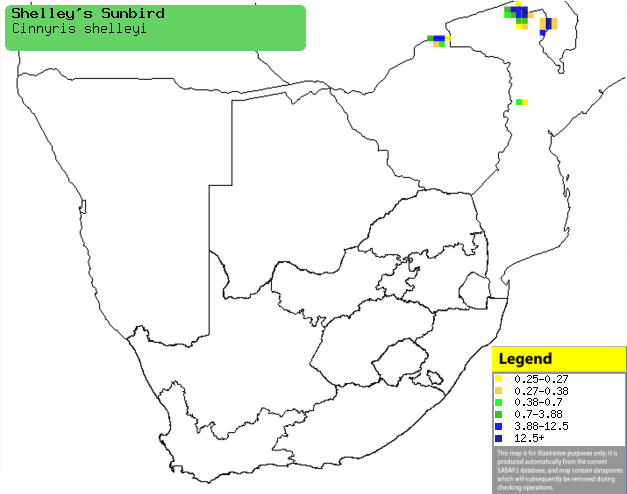|
Cinnyris shelleyi (Shelley's
sunbird)
[= Nectarinia shelleyi]
Swartpenssuikerbekkie [Afrikaans]; Shelley-honingzuiger [Dutch];
Souimanga de Shelley [French]; Shelleys nektarvogel [German]; Beija-flor de
Shelley [Portuguese]
Life
> Eukaryotes >
Opisthokonta
> Metazoa (animals) >
Bilateria >
Deuterostomia > Chordata >
Craniata > Vertebrata (vertebrates) > Gnathostomata (jawed
vertebrates) > Teleostomi (teleost fish) > Osteichthyes (bony fish) > Class:
Sarcopterygii (lobe-finned
fish) > Stegocephalia (terrestrial
vertebrates) > Tetrapoda
(four-legged vertebrates) > Reptiliomorpha > Amniota >
Reptilia (reptiles) >
Romeriida > Diapsida > Archosauromorpha > Archosauria >
Dinosauria
(dinosaurs) > Saurischia > Theropoda (bipedal predatory dinosaurs) >
Coelurosauria > Maniraptora > Aves
(birds) > Order: Passeriformes
> Family: Nectariniidae
Distribution and habitat
Occurs from southern Tanzania to Zambia, Malawi,
north-eastern Mozambique and southern Africa. Here it is generally uncommon in
northern Zimbabwe and north-western Mozambique, generally staying in miombo (Brachystegia)
woodland in the breeding season, after which it disperses into Zambezi teak (Baikiaea
plurijuga) and riparian woodland and reedbeds along rivers.
|
 |
|
Distribution of Shelley's sunbird in southern Africa,
based on statistical smoothing of the records from first SA Bird Atlas
Project (©
Animal Demography unit, University of
Cape Town; smoothing by Birgit Erni and Francesca Little). Colours range
from dark blue (most common) through to yellow (least common). |
Food
It feeds on nectar and arthropods, hawking prey aerially
and gleaning foliage in search of food. The following food items have been recorded
in its diet:
- Nectar
- Loranthaceae (mistletoes)
- Capparis tomentosa (Woolly caper-bush)
- Combretum (bushwillows)
- Tecoma capensis (Cape honeysuckle)
- alien plants
- Holmskodia (Chinese lanterns)
- Lagerstroemia indica (Pride of India)
- Arthropods
Breeding
- The nest is a sturdy, pear-shaped structure with a side-top entrance,
built of dry grass, leaf petioles and leaves secured with spider web. The
exterior is decorated with a few dried leaves and seed casings,
thickly-lining the inside with vegetable down and feathers. It is typically
attached to a twig in the foliage of a bush or in the canopy of a tree,
anywhere from about 1-10 metres above ground.
- Egg-laying season in Zambia is from August-October, peaking during
September.
- It usually lays 2 pale bluish grey eggs, heavily smeared with grey and
speckled with olive.
Threats
Not threatened.
References
-
Hockey PAR, Dean WRJ and Ryan PG 2005. Roberts
- Birds of southern Africa, VIIth ed. The Trustees of the John Voelcker
Bird Book Fund, Cape Town.
|
